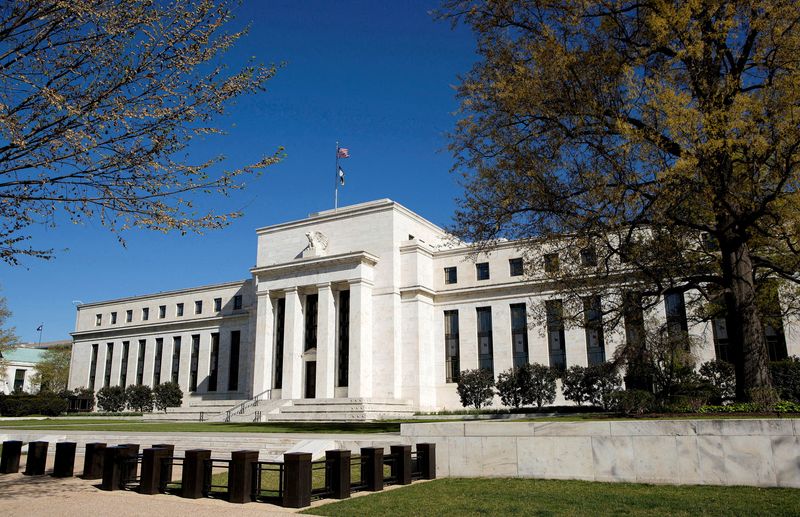Fed officials ponder whether rates high enough as inflation expectations jump
By Ann Saphir and Howard Schneider
NEW ORLEANS (Reuters) -Debate over whether U.S. interest rates are high enough deepened among Federal Reserve officials this week, and may be stoked further after a key survey showed a jump in consumers’ inflation expectations.
“There are … important upside risks to inflation that are on my mind, and I think there’s also uncertainties about how restrictive policy is and whether it’s sufficiently restrictive” to return inflation to the U.S. central bank’s 2% target, Dallas Fed President Lorie Logan said at a Louisiana Bankers Association conference in New Orleans.
“I think it’s just too early to think about cutting rates … I think I need to see some of these uncertainties resolved about the path that we’re on, and we need to remain very flexible,” Logan said, though she did not directly address whether she feels the Fed may need to again raise its benchmark policy rate from the 5.25%-5.50% range that has been maintained since July.
In on appearance on CNBC, Minneapolis Fed President Neel Kashkari said he’s in a “wait-and-see mode” in regards to what’s next for central bank policy and the Fed can stay at current rates “as long as needed” to bring inflation down. But he added there is a “high” bar to concluding that higher rates are needed to cool inflation.
Many U.S. central bank officials, including Fed Chair Jerome Powell, have said they still think further rate hikes will prove unnecessary.
In an interview with Reuters, Atlanta Fed President Raphael Bostic said he still thought inflation was likely to slow under the current monetary policy and allow the central bank to begin reducing its policy rate in 2024 – though perhaps by only a quarter of a percentage point and not until the final months of the year.
“I still have that belief,” Bostic said in the interview on Thursday, though “it is going to take some time” to be sure inflation is set to fall.
But the outlook is in flux after three months in which inflation stopped improving.
Data on Friday provided a further jolt in the wrong direction. Year-ahead inflation expectations in the University of Michigan’s survey of consumer sentiment rose from 3.2% to 3.5% in May, the highest level since November, and longer-term expectations ticked higher as well.
While a month’s reversal may not be significant, if it continues it would challenge the Fed’s current assessment that expectations are “anchored” – and add to arguments made by Logan and some others that rates may not be high enough to finish the inflation fight.
Anchored expectations are considered by Fed officials as an important sign of the central bank’s credibility, and an aid in bringing inflation back to 2%.
‘WALKING A TIGHTROPE’
Chicago Fed President Austan Goolsbee, in an appearance at the Economic Club of Minnesota, said a drift higher in inflation expectations “bodes awful” for further inflation progress, but the immediate results were not a concern.
“There is not much evidence that inflation is stalling out,” Goolsbee said, adding that he regarded current policy as “relatively restrictive.”
The University of Michigan data was released after Logan began her remarks, and she did not address it.
The survey also showed overall consumer sentiment nose-diving, a confusing signal that could point to lower consumer spending in the months ahead even as households expect higher inflation.
“The Fed is walking a tightrope as they balance both mandates of price stability and growth,” Jeffrey Roach, chief economist for LPL Financial, wrote. “Although it’s not our base case, we do see rising risks of stagflation,” in which growth slows and price increases remain strong.
The Fed’s preferred measure of inflation, the personal consumption expenditures price index, rose at a 2.7% annual rate in March, with little progress shown in the first three months of the year.
In an essay published earlier this week, Kashkari also raised the possibility that rates may not be restrictive enough, given the continued strength of the U.S. economy, particularly the housing market.
“It is hard for me to explain the robust economic activity that has persisted,” Kashkari said. “It raises questions about how restrictive policy really is.”
In contrast, San Francisco Fed President Mary Daly, in a taped interview on Thursday, said it is possible the “neutral” interest rate for the U.S. had risen a bit, implying that any given level of the benchmark policy rate would lean less on economic activity than it would otherwise.
But she said the solution for the Fed in that case would be to keep its policy rate at the current level for longer.
Even if the neutral rate is higher “we still have restrictive policy, which is what we want,” Daly said. “But it might take more time to … bring inflation down.”
(Reporting by Ann Saphir in New Orleans, Howard Schneider in Washington and Michael S. Derby in New York; Editing by Chizu Nomiyama and Paul Simao)










 Bitcoin
Bitcoin  Ethereum
Ethereum  Tether
Tether  XRP
XRP  USDC
USDC  Solana
Solana  Lido Staked Ether
Lido Staked Ether  TRON
TRON  Dogecoin
Dogecoin